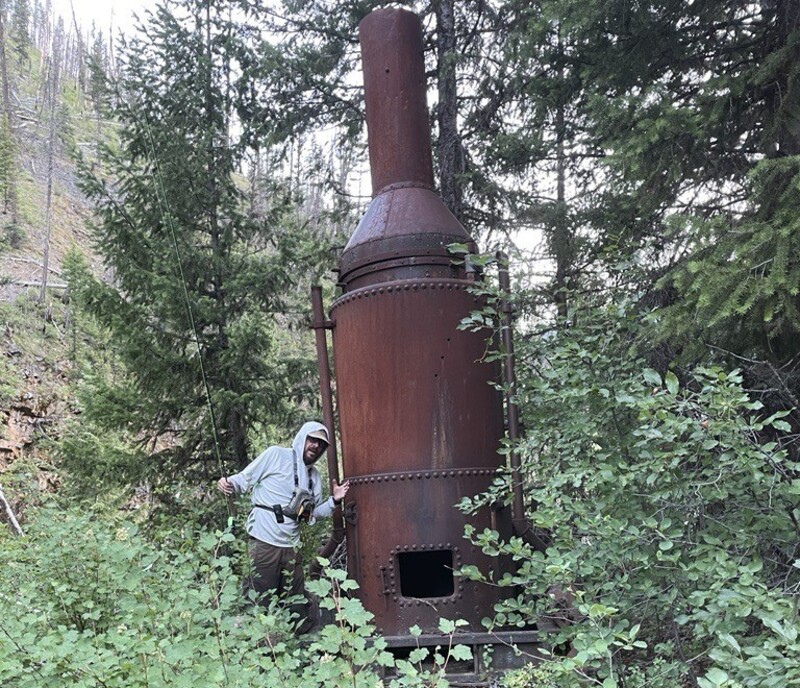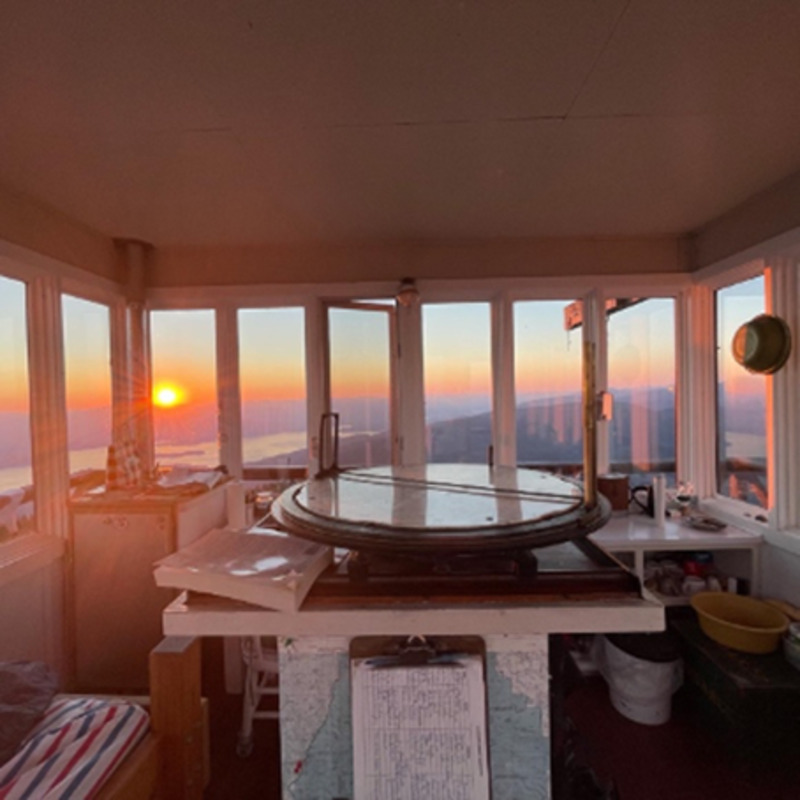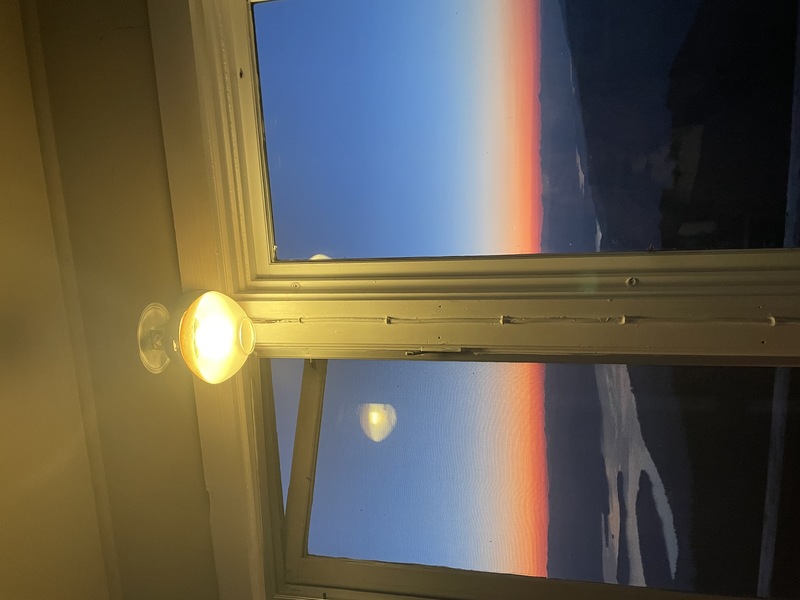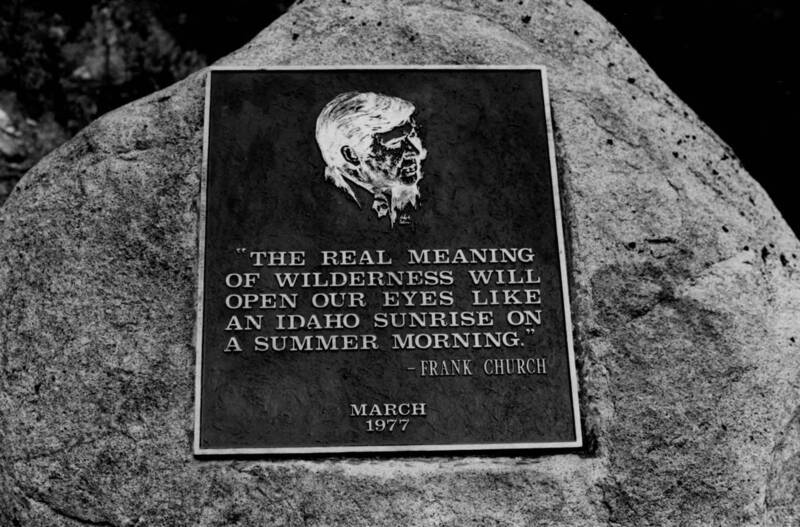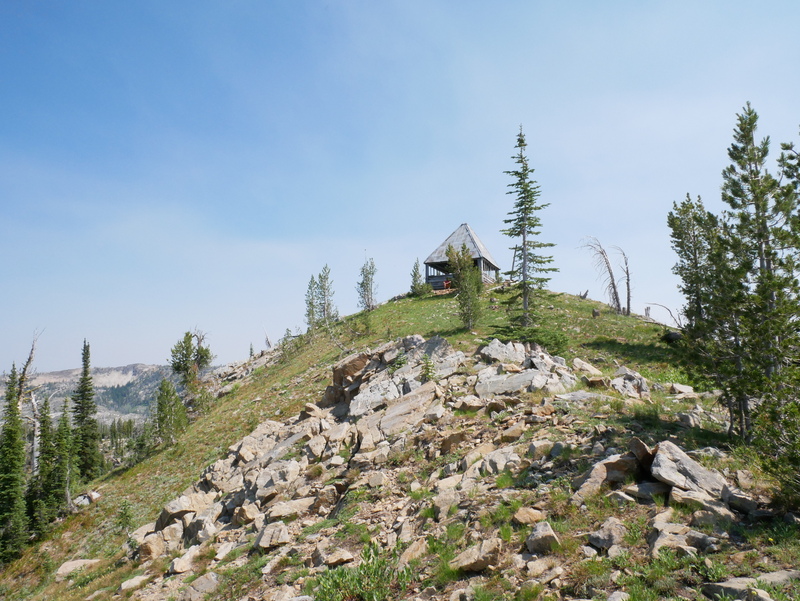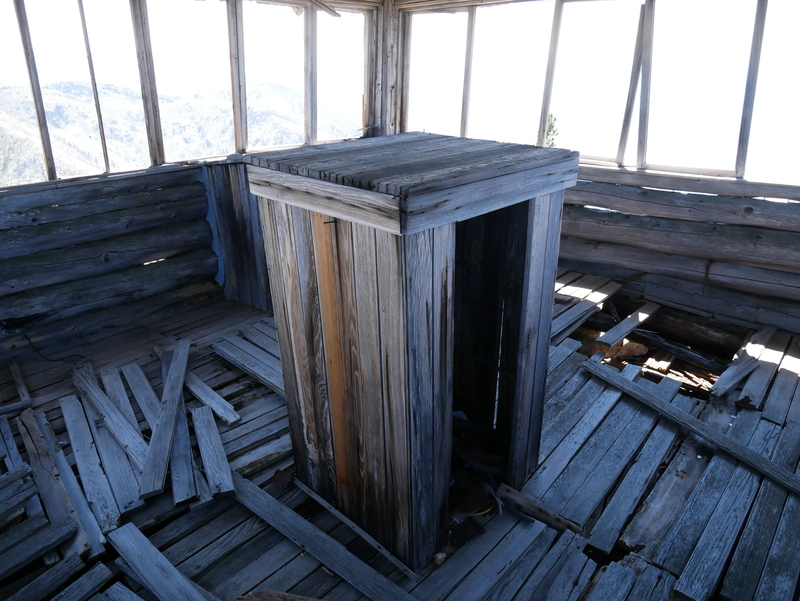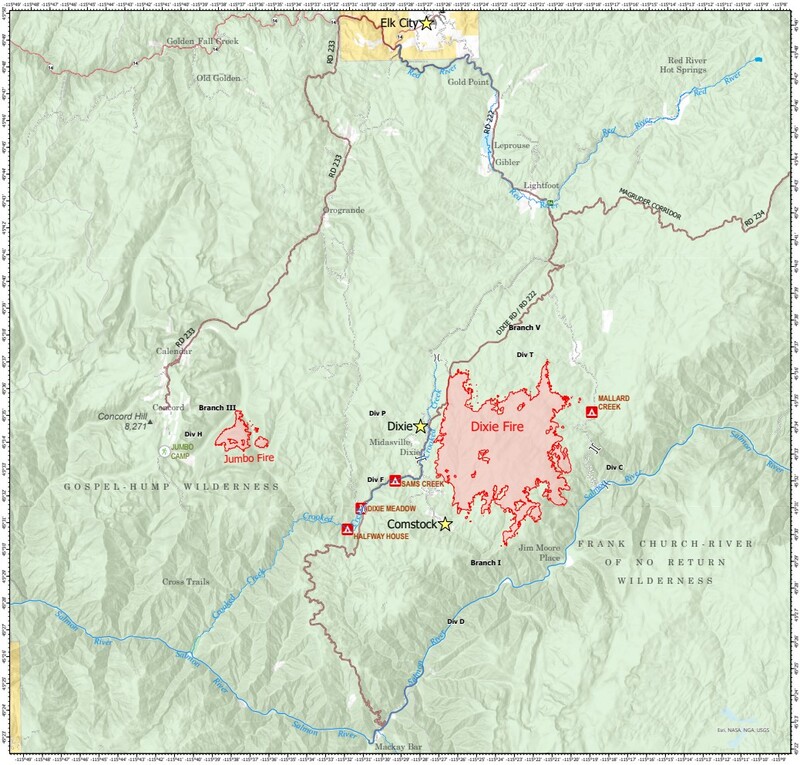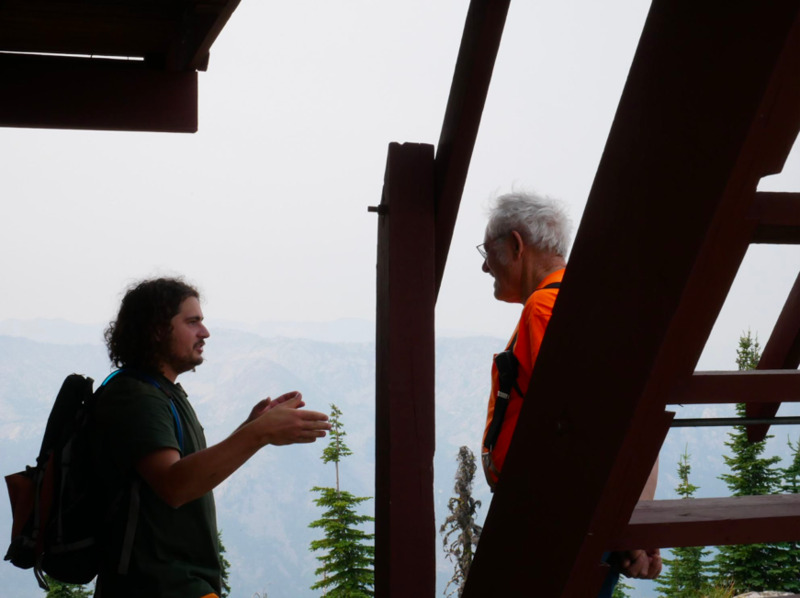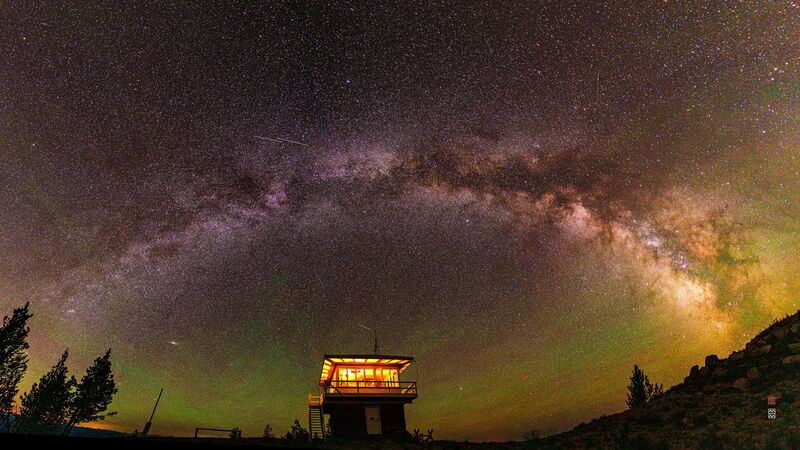Fire Lookouts and the Act of Remaining
By Michael Decker
Sundance Mountain
In the Department of Lands office in Nordman, Idaho, Pam Aunan, tosses me a forest green shirt with the word “fire” printed in large white letters on the front. I met Pam just two weeks ago when my colleagues, Jack Kredell and Chris Lamb, and I had interviewed her at Sundance Mountain Lookout in the Selkirk Mountains.
Pam, who runs the volunteer fire lookout program for the Preist Lake fire district, called me last week because an unexpected opening became available on the tower. She wanted to offer me and my dog, Trout, the chance to work for a few days as a lookout, thinking it would be a good opportunity for someone studying lookouts to be one. I agreed immediately, in part because Sundance Lookout was the site of a lightning strike that ignited the 1967 Sundance Fire, burning fifty-thousand acres and killing two firefighters. The fire was exceptional by mid-twentieth century standards because it made an anomalous run of sixteen miles in just nine hours. It was the focus of numerous studies on unpredictable fire behavior thereafter, although burns of such severity and unpredictability have become common as climate change’s effects ignite volatile fuel loads. These days, many wildfires are as severe as the Sundance Fire.
Wildfire’s increase is exacerbated by the continued settlement of areas inside the wildland urban interface or WUE: an area where developing human settlement meets what the U.S. Fire Administration calls “unoccupied land.” These homes are, unsurprisingly, at a higher risk of being destroyed by wildfire, which prompts complex fire reduction efforts by both private and government agencies. More specifically, in Fire: A Brief History, fire historian Stephen Pyne defines the WUE, and those who live on it, as “…still urban sprawl, even when populated by people who want woody jungles for privacy and naturalness.” The WUE, as experts like Pyne are quick to point out, is a space where the needs of human and non-human worlds often clash.
A growing wealth inequality along the wildland urban interface also contributes to Idahoans’ frustrations many long-time Idahoans have toward wealthier part-time residents with second homes. The newcomers dream homes typically receive more firefighting resources, often bankrolled by insurance companies trying to protect expensive assets; in the Priest Lake fire district, most of these homes are built where the lake shore meets large adjacent swaths of unoccupied land. Lookouts—like Sundance—are either placed on or near the wildland urban interface or overlooking valuable stands of timber.
Fire Lookouts were created by the Forest Service in the 1910s under its early philosophy of sustainable forest management. At the time, this meant managing timber products, although it has since expanded to include recreation. When Gifford Pinchot—along with Teddy Roosevelt—founded the Forest Service in 1905, he championed economic principles of land conservation and sustainable development.
Inspired by lookouts in Europe, Asia, and more recently by private lumber companies, the Forest Service began outfitting and utilizing lookouts during the early-twentieth century. Initially, the Forest Service was met with opposition from private landowners and capitalists because they felt that the agency would inhibit the free and largely unregulated market of logging. During the summer of 1910, however, a series of wildfires in Idaho and Montana converged into one giant blaze that was roughly 260 miles long and 200 miles wide. Three-million acres burned, and eighty-five people died. Numerous acts of heroism and a swift response by the Forest Service bolstered public support for the nascent agency.
Emboldened by a changing public perception and the need for more effective fire monitoring networks, the Forest Service began building thousands of fire lookouts over the next twenty years. After WWII, military technology, including aerial capabilities, was repurposed for fire detection purposes. The 1940’s marked the beginning of the technological obsolescence of fire lookouts.
Today, fire lookouts are placed intentionally on an interface separating land classifications and are overseen by different agencies, businesses, and individuals. They are also decommissioned on this same principle; lookouts found in the center of what is now federally designated wilderness, and thus not managed as rigorously for fire, are often no longer operated and unless they have special cultural or personal significance, they are often left to decompose back into the earth.
The lookouts that are staffed and operational for firefighting purposes are commonly in strategic locations to observe fire strictly for the purpose of making sure it does not cross the wilderness boundary. Examples of this are: St. Mary’s Peak near Lolo and Stevensville, Sundance Mountain near the towns of Collin and Nordman as well as significant recreational activity, and Ruffneck Peak nearby the Stanley Basin.
Not all non-operational lookouts are abandoned, however. Some lookouts built in scenic locations on top of craggy mountains are now managed by the Forest Service as backpacking shelters or even rentals. In Idaho, which has more designated wilderness than any other state and, by no coincidence, more fire lookouts, abandoned cabins freckle the interior of its wildlands.
And on private property, some landowners have relocated fire lookouts and now list them as AirBnB rentals. This shift in purpose reveals a changing relationship to wilderness over the last century; lookouts were first built not as conduits of a wilderness aesthetic but rather as extensions of logging and mining in the early twentieth century.
Pam’s boss, John, slides a map across the table. It shows the topography surrounding Priest Lake and how the Selkirk Mountains make a skinny valley that crosses the Canadian border. Lightning bolts mark where several strikes occurred a week ago during a June thunderstorm. These strikes are concerning because Idaho is in the early stages of its worst drought in several decades. I will be on the tower during what is projected to be the hottest recorded temperatures ever in the Northwest: one-hundred-and-thirteen degrees Fahrenheit, tomorrow.
Pam and John tell me to watch for sleeper fires at the strike locations. Sleepers are burns that do not immediately consume large amounts of fuel, but instead sit dormant and produce periodic smoke events before erupting into a larger fire, sometimes up to two weeks after initial ignition.
I shake their hands and thank Pam for the opportunity. She smiles and adjusts her baseball cap and tells me to have fun and to drink alcohol in moderation because of the altitude. The Idaho Department of Lands gave me a truck to use. I open the door and Trout jumps up on the seat. Around 9 a.m., the temperature is approaching ninety degrees Fahrenheit.
I look at my Idaho Department of Lands shirt, the government truck, and the black highway leading me like a river to Sundance Lookout high in the Selkirk Mountains. The truck kicks up dust, as we climb the poorly maintained service road, and the all-terrain tires are tested by sharp rocks while the undercarriage narrowly misses deep ruts and boulders. I forget to shift into four-wheel drive and, briefly, the truck’s tires spin free on the steep slope. Trout sits up abruptly and observes the situation. Don’t worry, Bud.
The burn scar is the first thing I notice when cresting the peak of Sundance Mountain: despite over half of a century of regeneration, the vegetation is noticeably stunted compared to nearby mountain slopes. The heat thickens the air as I close the truck door and wave to the lookout staff being relieved from duty. Her two dogs run to the edge of the fifty-foot-tall tower, and she waves back—Trout looks at them uninterested.
I inspect the inside of my new home which has a dish sink, propane stove, and a small refrigerator in the corner. Gas lamps hang on the wall above a small bed that I throw my sleeping bag over. I step onto the deck and see smoke obfuscating mountains to the east and north. With aerial surveillance taking place, I question how much of this antiquated role is necessary. I crack a beer and drag my camp chair to the deck. Trout sits next to me.
At the center of the tower is a podium on which sits a large steel table holding the Osborne Fire Finder. Lookouts use this device to precisely locate fires. It has a three-hundred-and-sixty-degree alidade surrounding a map with the fire tower at its center. The Osborne is used to call in the location of a smoke using degrees and minutes that are communicated to a fire dispatcher over the two-way radio system installed below the podium.
The Osborne Fire Finder was manufactured between the years 1920 and 1935 by Leopold and Stevens, a telescope manufacturing company, which also produced replacement parts until 1975. Production halted because new fire detection methods had made the fire finder more or less obsolete. However, Osbornes have made an unlikely comeback recently. After a substantial increase in wildfires in the late-90s and early-00s, the federal government contracted with a new manufacturer, San Dimas and Technology Center, to resupply fire lookouts with Osbornes and to produce replacement parts as needed.
Why have federal and state governments and timber protection agencies (the latter usually funded by private logging companies) kept the human-staffed fire lookout around? I can think of many reasons why we should have them. For instance, shouldn’t we be physically present in the places we are managing rather than making decisions from a God’s-eye view? Even in wild places, should this human element be removed? I use “wild” according to the wording of the Wilderness Act of 1964 which defines wilderness as “a place where man himself is but a visitor who does not remain.”
Yet it is precisely because the fire lookout allows us to remain in wilderness so effectively that they have not disappeared entirely. The phenomenological relationship to place remains valuable not only to individuals for personal reasons, but also to agencies like the Forest Service or Idaho Department of Lands. It would be incorrect to analyze the modern fire lookout without acknowledging the very real service it still provides.
Lookout staff not only locate and call in new fires, they also monitor existing ones in real time and communicate with on-the-ground fire crews. Heat mapping can provide information about fire spread and size, and sophisticated weather modeling can determine precipitation levels, wind speed, and heat index; however, attentive fire lookouts experience these phenomena while searching for anomalies in the landscape. Technology has augmented, even reduced, the role of the human fire lookout, but it cannot entirely replace it.
Through the window, a breeze sneaks in. The tower is about 15 degrees cooler than the valley. The bear grass makes the air smell sweet, and the last patches of snow are melting at a perceptible rate. A pine snag on the ridge to my southeast stands in an otherwise healthy forest, and below it the highwater mark of evening inches closer. I fixate on this steady pull between night and day. The sun’s geometry positions the tree at the fulcrum of light and dark. I glance at my phone: 7:38 p.m.
The sun dips behind the mountains. The evening neon radiates through bars of smoke rising above the Selkirks, and a stratum of ozone and geology slowly dims into the night sky. Venus appears to my west. The universe flickers on. The Milky Way swirls like a parking lot oil stain as I lie in bed reading William Least Heat-Moon’s Blue Highways.
In Blue Highways’, young Heat-Moon has lost his English lectureship, and his marriage is dissolving. Devastated, he sets out on a circular journey traveling from New England and through the southwestern United States, into the Pacific Northwest before veering east again. The only discernible destination is where he began. He drives a green Astrovan named Ghost Dancing after the Native American ritual which foretold the return of departed spirits and the end of colonial expansion.
Making his way through the American Southwest, Heat-Moon reflects on the smells and nuances of the central Nevada desert. Its lonesomeness makes him consider the Latin root of the English word vacation, which is vacare (meaning “to be empty”). He uses the open space to infuse himself with impressions of the landscape and foster a connection to the non-interior world. To see himself out there in the desert and merge with the interstitial absence of the Nevada landscape and finally be “absorbed” by it.
Heat-Moon looks out of Ghost Dancing and sees himself reflected in the pellucidity of the van window, transposed onto the desert. Quoting Whitman, he describes “…the thoughtful merge of myself, and the outlet….” Seeing yourself as connected to and part of the exterior world is a common first step toward an ethics that accounts for the interconnected nature of the world and cosmos. Lookouts seem to facilitate this swiveling between self and the more-than-self because of their innate architecture. The panoramic windows provide easy access between the inside and outside world and allow one to glean their place in the larger landscape while protected from the elements.
I put down Blue Highways and turn off my headlamp, get out of my sleeping bag, and walk to the window. Between the inside of the cabin and the night sky, the windows and propane lamp transpose my face onto the universe. I walk to the deck and suddenly all that remains is black plasma where my face was.
Chicken Peak
Jack, Chris, and I have driven to the edge of the Frank Church River of No Return Wilderness, seventy miles from McCall, Idaho along a dirt road, stopping to fish the Salmon River which early settlers called “the river of no return.” Drifting my caddis along the water, I think of the ghosts of the Tukudeka, a mysterious mountain tribe of Shoshone-Bannock Native Americans, colloquially known as the Sheepeaters.
We will make the twenty-mile hike from Mosquito Ridge to the Tukudeka namesake, Sheepeater Mountain, which is home to one of the most remote fire lookouts in the world. This place’s common name The Frank Church, or usually just The Church, was given after one of the key architects of the Wilderness Act of 1964, Idaho Senator Frank Church. Church remains one of the most prolific progressive voices ever in Idaho politics, and one of the most accomplished establishment environmentalists in American history. As the floor speaker for the passage of the Wilderness Act, he played a key role in drafting and signing the law that denoted this area as wilderness.
We wake up on Big Creek, a main tributary of the Salmon River, and drive up a rugged road to the Mosquito Ridge trailhead. On the way, we pass the ruins of mining towns and go through a small creek. We have taken Chris’s 1996 4Runner that has a failing differential and overheats periodically because we fitted the wrong filter to it when changing the oil before we left. There is no auto parts store for a hundred miles, so we just add oil we bought from an old man on the side of the road.
The road narrows and we pull over at a shallow divot. Loading our packs, I read the trailhead sign and notice that there are no other hiker census cards in the wooden Forest Service box. A laminated sign announces we are at the official boundary of the Frank Church River of No Return Wilderness.
The word “wilderness” is deceptively unstable. It is a noun that functions like an adjective. Older mentions of wilderness often referred to something’s wilderness quality or used the indefinite article like in “a bog” or “a city.” It is only very recently that we have “The Frank Church Wilderness.” Thus, it is important to think of wilderness not only as a setting but also as a construct. As postmodern historian William Cronon asserts in his essay “The Trouble with Wilderness” (1996), “Far from being the one place on earth that stands apart from humanity … [wilderness] is quite profoundly a human creation – indeed the creation of very particular human cultures at very particular moments in human history.”
The relationship of the fire lookout (both human and structure) to wilderness seems obvious. They do, after all, oversee such areas, or are at least adjacently located to them. However, it is only by elucidating wilderness both as place and concept that this relationship is fully understood. Wilderness boundaries established through legislation are fixed, whereas the concept of wilderness is not.
Far from the modern perception of wilderness, early American colonizers brought with them the European fear and hatred of wilderness which they believed impeded human progress. Tellingly, Andrew Jackson said in his 1830 inaugural address that “what good man would prefer a country covered with forests and ranged by a few thousand savages to our extensive Republic, studded with cities, towns, and prosperous farms, embellished with the improvements which art can devise or industry execute.” However, Roderick Nash points out in his tome Wilderness and the American Mind (1965) “modern man [felt] as insecure and confused in urban settings as he once felt in the forests among the wild beasts…” by the end of the century.
Further, Americans began ascribing the same aesthetic value to wilderness as to the Jacksonian art and industry. Bob Marshall, founder of The Wilderness Society, in his 1930 essay “The Problem of the Wilderness” (a similar title to Cronon’s “The Trouble with Wilderness”) says “One looks from outside at works of art and architecture, listens from outside to music or poetry. But when one looks at and listens to the wilderness, he is encompassed by his experience of beauty, lives in the midst of the esthetic universe.” By the inception of fire lookouts, there was a full-blown battle over the meaning of wilderness in both thought and in practice.
Two wings of environmental thought were crystalizing in the late nineteenth and early twentieth centuries that still frame the contemporary wilderness paradigm. Conservationists (championing sustainable forest use for economic purposes) and preservationists (preaching wilderness non-interventionism) split from one another around the time that lookouts were first utilized to protect forest “crops.” The Forest Service, aided by the New Deal’s Civilian Conservation Corps, built thousands of fire lookouts, including Chicken Peak (1930) and Sheepeater Mountain Lookout (1934). The sole purpose for these lookouts was negating the wilderness condition through systematic fire suppression. The preservationists, led by John Muir, Aldo Leopold, and Howard Zahniser, fought legal battles over the preservation of Yosemite’s Hetch Hetchy Valley, Dinosaur National Monument, and the Grand Canyon, which led to the ratification of The Wilderness Act in 1964.
The creation of wilderness areas such as The Church directly correlates with the decline of fire lookouts. After all, there is no reason for a human made structure in what is legally defined as a place “where man himself is a visitor who does not remain.” However, fire lookouts sometime in the middle of the twentieth century become endowed with a similar scarcity as wilderness, and a different, less utilitarian gaze begins to be cast from them. As Aldo Leopold said of wilderness, “only when the end of the thing is in sight do we discover that the thing is valuable.”
Writers like Gary Snyder, Jack Kerouac, Edward Abbey, and Phillip Whalen staffed lookouts in the 1950s and 60s. Gary Snyder, rather than describing the official management purposes of lookouts, “[sits] cross-legged, in the practical and traditional posture of a Buddhist meditation.” Jack Kerouac, too, not encountering wildfire per se, came “face to face with [himself].”
By the 1980’s it was clear that the real cultural significance of lookouts rested not in their utilitarian purpose, but rather in their connection to human wilderness: an artificial landscape at the nexus of the material world and spirituality that has emerged in reaction to rampant techno-industrialism. In Ray Kresek’s 1987 lookout “bible”, Fire Lookouts of the Northwest, he asks “Where have all the lookouts gone?” Rather than evoking nostalgia for antiquated management practices, Kresek outlines the troubles one returns to in civilization: “his buddy had run his car into a tree, his family was sore because he didn’t write all summer, and his girlfriend was going steady with someone else.” Instead, the lookout wishes to “return to his summer job in the wilderness atop Mount Sentinel … only to be told that his lookout was no longer there. They burned it down last fall.”
Most often, lookout life embodied not the clear segregation of wilderness or civilization, but rather the blending of the two. For instance, in “The Lookout”, Doug Peacock pours a bottle of 1970 Les Forts while listening to a Bach Cello solo “[feeling] like Captain Nemo in my mountain top glass house” as a violent thunderstorm passes over. Suddenly, someone radios him to confirm his official pack-out date. He then tries to regain his “sense of solitude.”
Sheepeater Lookout is the last remaining staffed lookout in The Church, and recently only for emergency purposes. As we climb the Mosquito Ridge trail, the outline of Sheepeater Peak briefly comes into view. Last month, we interviewed a lookout enthusiast named Richard Holm who also restores lookouts in his spare time. In his 2009 book, Points of Prominence, Holm explains that Sheepeater exists at the edge of lookout evolution, and that those who staff it are primarily “fire monitors” who make sure that fire does not cross the wilderness boundary. Their new (and decreased) function is of interest to Holm, though, who points out that the average fire size has grown from just a few thousand acres to “100,000 acre fires [becoming] common place.” Such an increase is evidence that the same human conditions exacerbating fire in National Forests, TPA lands, private property, and National Parks, are present in wilderness areas as well.
From Mosquito Ridge, the Salmon River rushes five thousand feet below me and high mountain wildflowers sway in the warm updraft. On a ridge above us Chicken Peak is the most unique fire lookout I have seen in the entire state of Idaho; its prominent roof and neon orange paint helped pilots navigate over empty swaths of terrain before GPS technology. Chicken Peak is the halfway point between the Mosquito Ridge trailhead and Sheepeater Lookout.
During the years 1937 and ‘38, Myron and Aloha McCoy staffed Chicken Peak. Aloha claimed that this lookout took on more lightning than any other lookout she ever staffed, and that “the electricity literally dripped off the grounding wires.” I can easily see why: Chicken Peak, unlike some mountains whose shoulders gradually marry into other peaks, is very exposed. I bet this cabin rocks like a boat during storms.
Inside, the floor is collapsing around an intact podium upon which the fire finder once sat. Carved initials and corresponding dates have collected over the years, creating a kind of palimpsest. Jack carves JK + MM, and I take out my pocketknife and carve MD + KW with a heart around it.
“Oh, shit, smoke,” says Jack. I turn around and stare through the smashed windows, my gaze directed in a very particular way, and see a plume of smoke rising from behind a ridge. We agree to keep an eye on it and not hike any further. Although the fire appears to be coming from across the Salmon River, we would, foolishly, be going closer to it if we continue our current route. Jack says his friend Andy is an expert with InciWeb, which is a website with information about active wildfires. We send a message using my Garmin InReach.
This is Jack. We are on Chicken Peak in view of a wildfire east of Dixie. No danger to us currently. Could you get us some info on it?
Hours pass as we watch the plume grow into a cloud and banter about our options. For a moment, the sun bursts through the smoke and beams a kaleidoscopic refraction. “Watch”, says Chris, and suddenly, I am compelled back inside the deteriorating tower. I step across the floorboards, careful, so as not to trip. The panes where the windows once were makes a frame around the smoke and holds the plume in place as if it were a painting.
Standing at the podium, I imagine my hands resting on the fire finder and prepare to maneuver the alidade. I close one eye and look through the crosshairs to sight in my smoke. After all these years, there is still a pull; my gaze is directed in a very particular way and for a specific purpose.
Framing the fire from the inside feels different than being outside. With my hands on the podium, I feel a sense of safety and order; the window objectifies the fire and thus controls it. Outside, I feel disoriented and less in control. The twinned histories of conservation and preservation are at odds with each other here. The cabin is at once being reclaimed and yet still functions to conceptualize the landscape in human terms.
“What do you think?” I ask Jack and Chris. “I guess even if there’s a five percent possibility that it’s dangerous, which is probably what we’re looking at, we should turn around,” Jack replies. I can tell that he is annoyed by me and Chris who are much more afraid of the fire spreading past the river than he is. Chis nervously affirms that it would be unwise to continue hiking toward the fire.
My Garmin rings and announces Andy’s response that comes through in limited character segments:
Planned Actions: “Today, Aviation and ground resources are continuing structure protection work and improving the roads and fuel breaks near the community.”
Projected Incident Activity: “The fire has continued to burn actively and spread in all directions, and fire managers are anticipating that it will continue today under current conditions.”
Also, an hour ago they posted an Area Closure for the Dixie Jumbo Area.
Looks like there might be another fire a little west of Dixie near Buffalo Hump.
From InciWeb: “The Dixie Jumbo Fire is located 40 miles southeast of Grangeville, Idaho and 15 miles south of Elk City, Idaho. It is
Located on the Nez Perce-Clearwater National Forest Red River Ranger District. It was detected on the afternoon of July 5, 2021.”
Our decision is made. With the fire uncontained and spreading in all directions, and despite a river and ridgeline between the fire and Sheepeater Lookout, we would be unwise to not turn around.
Last spring, I interviewed writer Don Scheese who lived and worked in the Frank Church as a fire lookout in the 1980s. He was stationed on Ruffneck Lookout close to the town of Stanley, Idaho. After eighteen summers as a fire lookout, Scheese wrote a book about his experiences called Mountains of Memory. In it, he defines landscape as a “modified space” which is the result of changes made to the land by humans. To Scheese, it was the people who lived in landscapes “especially the various inhabitants of the Frank Church over Millennia,’’ who created them through their needs and desire. It was them, Scheese says, “who interest me the most.”
I notice something hidden in the dirt. It is a small button from a pair of Levis jeans. I pick it up and examine it. The metal is degraded enough that it could be twenty, even thirty, years old. Perhaps it was dropped by someone in the 1980s, and at the same time, Don Scheese sat on Ruffneck Peak. I clasp the button tightly and slide it into my pocket before turning back down Mosquito Ridge.
Diablo Peak
Jack, Chris, and I have spent the last two weeks traveling across Idaho— beginning in the Frank Church Wilderness and now moving onto the Selway-Bitterroot— taking photos of fire lookouts and interviewing those who work on active sites. We feel beat up and tired, our skin is leathery, and our lips are cracking from the drastic shifts in elevation.
My girlfriend, Kourt, has driven down to the Lochsa country of central Idaho (north of The Church) to meet us. The Selway-Bitterroot Wilderness touches seven ranger districts, the Lochsa being one. Together we are hiking to Diablo Peak where long-time wilderness activist Bill Moore spends two weeks each year as a lookout staff. Like Pam, Bill runs a volunteer lookout program that provides an additional level of fire reduction and helps keep the tradition of lookouts alive.
Bill is the son of the late Forest Service Lochsa district ranger and activist Bud Moore, who implemented a multiple-use policy in the Selway-Bitterroot Wilderness. Multiple-use policy aims to manage competing needs and values to achieve ecosystem health alongside human society’s economic demands. Bud was one of the first lookouts in this part of the country and spent several seasons on McConnell Mountain, just over the ridge from Diablo.
Bill tells us that Bud began his tenure with the Forest Service as a lookout and smoke chaser. He was stationed at McConnell Mountain in 1935 where he stayed for several years and found a flaw in the Forest Service’s fire watching approach: during lightning storms, he was confined to a cabin below the tree line which had been outfitted to withstand strikes. Bud constructed a small tower from rocks where he watched for lightning above the tree line during summer storms. From this vantage point, he made notations about strike locations and improved his overall accuracy and effectiveness as a fire lookout. When the district ranger came to check on Bud, he was impressed with his design and ordered a fire lookout be built in place of the rock pile.
Bud left the Selway-Bitterroot region to fight in World War II but returned and became district ranger in the early-1950s, before it was designated as Wilderness. At the time, they enforced the Forest Service’s infamous 10 a.m. policy: all fires were to be exterminated by 10 a.m. the following morning. However, enabled by the signing of The Wilderness Act of 1964, the Selway-Bitterroot became protected Wilderness, which meant that a new set of fire policies were put in place from total fire suppression to wildfire as prescribed burn.
In a sense, Bud always recognized that some of his policies, retrospectively, were harmful. This included spraying DDT and suppressing fire. Bud often admitted shortcomings and proposed different management models, ones that imagined more sustainable environmental futures. For example, he led the reintroduction of controlled burns in fire deficit areas in the Selway-Bitterroot. Many of his thoughts and actions can be found in his sprawling book The Lochsa Story: Land Ethics in the Bitterroot Mountains. Tellingly, this book was written a full decade prior to its publication (1996) because many of the ideas within it were not yet popularly accepted, and, as Bill points out, Bud refused to vanity publish.
“Bill!” I call out as the shape of Diablo’s lookout materializes through the ubiquitous wildfire smoke. I see a fluorescent work shirt and a pale hand wave howdy. Bill is a septuagenarian who moves slowly but confidently, the result of a life spent hiking and living in a big open country. He smiles an honest, crooked smile that makes me feel at home. He invites us up to the cabin and brews a pot of coffee creating an effortless and organic hospitality, and prompting conversation in a way that only a pot of coffee shared among friends can.
The tower is full of books (notably, Kresek’s Fire Lookouts of the Northwest) and gear that lookouts have left over the years. The design of most towers is the same: a propane stove, small refrigerator, wooden framed bed, and shelving around the ceiling for holding canned goods and books. A map of the tower’s surrounding topography is attached to a wooden board that folds down from the ceiling above the bed, intended for use in conjunction with the fire finder. Most of the tower’s belongings are somewhat antiquated; however, there are modern objects as well: a Garmin InReach on which I glanced a message asking Bill if he had been evacuated yet (the Lolo Complex fires are burning nearby), his iPhone that he uses to snap a portrait of our team, and a newer REI backpack near the bed.
“Could you really quickly give us a three-sixty view here?” Chris begins the interview. Bill chuckles and points his finger to the east.
“I’m not sure how to put it. We’re sitting on the ridge between the Selway drainage and the Lochsa drainage. You got Big Fog lakes up here in the fog or the smoke. You can just see the tail end of it. It’s about a mile long and has a sand bar at one end. Wonderful fishing. You come up over this ridgetop here, that’s Genette Mountain. You go down into Little Moose Crick and that’s Dead Elk Point right there. There’s a little low one called Footstool. Go down this way and that’s Goat Lakes. Behind them is Wahoo Point and Battle Creek Ridge. That is all in what used to be the Nez Perce National Forest. It’s now the Clearwater-Nez. Then you go around this corner where the smoke is really heavy and that’s Elbow Bend. Between Elbow Bend and that corner is a huge old-growth cedar grove that was written up in the National Geographic in 1935. That ridge that’s coming down like that is Maple Ridge. There’s a little mountain range called the Graves Range, and right out there is Graves Peak.”
As Bill describes the landscape, I imagine him oscillating his body from left to right, creating an arc of the horizon along an azimuth that traces a three-hundred-and-sixty-degree trajectory as his tinted glasses reveal one squinting eye that identifies the landmarks through an internalized parallax view. The other striking thing is that we cannot see any of the places Bill talks about; the smoke is too thick. From the tower, the landscape appears as a white purgatory upon which nothing can be discerned; it is a strange canvas which defamiliarizes the familiar. However, Bill quickly points out that this smoke indicates something natural occurring on the landscape, and that the high-visibility days of his and Bud’s early time as fire lookouts was the result of “Smokey the Bear’’ and the Forest Service’s 10 a.m. policy.
We sit around for hours listening to Bill’s stories, and he goes into extensive detail about his father’s work in the district. He has interesting ways of pronouncing words: Diablo, for instance, is pronounced “die-ablo.” I also notice Bill’s childlike essence: though time has aged him, I have no problem imagining him young, and when he talks about Bud, he always refers to him as “Pops.” Bill celebrates his father, but there is pain in his voice. It is obvious how much he misses Bud, who represents a past way of life and attachment to the land. The act of maintaining lookout structures and lookout volunteer programs is an attempt, among other things, to keep this attachment alive. Storytellers like Bill, and the rest of us, really, see the world through an aggregation of experience. Places do not, to humans, exist in isolation of memory, and perhaps except for the Nez Perce who were born from this land, Bill and Bud are as infused with the landscape as anyone.
In Lochsa Story, Bud tells the story of himself as a young trapper on his first solo trip into the Bitterroots. Near a small lake in the Valley of the Brushy Fork, Bud comes face-to-face with a large grizzly bear, a species that was already on its way out of the area. Frozen with fear each stare into the face of the other and the human and bear come to an understanding as Bud says, that “The forests belonged to the bear, but the meadow was mine; so I camped at its edge beneath thick-limbed spruces that would shield my blanket from the frost.” This encounter becomes central to the land ethics that Bud presents in his book, and how he frames multiple-use theory as a viable management path forward; the idea that he and the Grizzly agree to live out their distinct yet still intertwined existences becomes a challenging idealization that is critical for the survival of both human and bear.
Some say that fire lookouts give those who stay on them a long view, not just in-terms of the twenty-five-mile radius around the tower, but a view that looks deep into the past and future; and like the tower’s view, Bud believed that the remnants of his encounter with the bear–“[his] boot prints mingled with the grizzly tracks on the trail”—said something about where it is we come from, and where it is we are going, like the light of a distant star glimpsed from a lookout during the night, at once happening and already having happened.
The futurist approach has been the most effective for wilderness preservation. For instance, prior to signing the Alaska National Interests Land Act in 1978, Jimmy Carter stated that “We have the imagination and the will as a people to both develop our last great natural frontier and also preserve its priceless beauty for our children and grandchildren.” This same rhetoric of conservation on behalf of future generations has permeated the conversation of most environmental issues today, including that of global climate change. As Roderick Nash compares “Modern civilization, it is said, needs wilderness, and if wilderness is to exist it surely needs the protection of a self-restraining society.”
The Wilderness Act of 1964 is arguably the most radical environmentalist action ever taken at the federal level. Quoted more than any other section though is its stance on permanent human settlement, which states that “man himself is a visitor who does not remain” in the wilderness. Yet, this is untrue. There is archaeological and anecdotal evidence that humans have moved across The Church and Selway-Bitterroot for thousands of years. Everywhere, there is proof of humans in the wilderness.
This ecological amnesia is what Cronon asserted was the danger of official wilderness boundaries: that they would separate our everyday lives from the conservation mindset of wilderness. Humans, and specifically settler-colonial societies, he worried, would continue to justify more localized forms of environmental neglect if they could imagine untouched nature elsewhere.
Environmental and queer activist, Nicole Lefavour, staffed fire lookouts for several years, and in her essay “Listening to Voices in the Wilderness” describes how, “decades of lookout use show on the tree stumps and snags below. Every year we have to walk farther for the wood, the skeleton of another ancient limber pine turned to a streak of wood smoke stretches across the sky.” LeFavour shows that remaining in such a way makes one more in tune with resource use. She continues to wonder that “somewhere far away men and women in the depths of marble buildings debate our need for wilderness.” LeFavour is concerned with location and how politicians make high-stakes decisions while remaining disconnected from wild places.
Lookout structures have a long history of producing lifelong lovers of the wilderness and some of its most passionate protectors. Ray Kresek, for instance, says that he started his forestry career on a lookout and made the decision to end it there as well; in between, he established the Salmo-Priest Wilderness. However, the Forest Service announced in 2023 during a Senate Budget Committee hearing that they intend to further reduce staffed lookouts. Lookouts, according to National Budgets Director, Mark Lichtenstein, will be replaced by sophisticated smoke watching cameras that are augmented using artificial intelligence. To what extent fire lookouts will remain is uncertain, but the direction is clear; and as we reduce our reliance on human experience, I wonder how it is we will remain.
I sip my coffee down to a black residue as we start packing our cameras and prepare to head back down the trail. The smoke, I think, has gotten worse since we arrived. Bill gestures vaguely out toward McConnell Mountain where his dad had worked. In the end, lightning ignited a wildfire five miles from Bud’s old rock pile and three days later the now-decommissioned McConnell Mountain fire lookout burned down. Bill wrote that Bud, who passed away in 2010, would not be sad because “the story is a lesson about the circle of life and death in the Wilderness world.”
Bud’s personal land ethic emphasized that no human alteration to the land is without consequences. Any changes to an ecosystem will have unforeseen and unintended consequences. Making good management decisions requires living and working in a single place for a lifetime rather than for short durations. “Nature’s ways” Bud believed “have to be respected if we are to prosper very long.” And these ways, he reminds us, are intricate and need both human emotions and applied science to become defensible.
After we return to our busy lives at work and school, Bill will still be here. I think that being here does matter, and that despite cost, efficiency, or current politics, the very act of remaining in one place and becoming familiar with its personality is more important than ever. I pause for a moment and inhale the smokey air. The wind blows across my cheek. I think of it fanning the flames of the nearby Lolo Complex Fires. Ground squirrels chatter in the nearby rocks and where the sky once was is now only smoke. I would, if possible, lie down next to the lookout in the bear grass and never leave.
Citation: Decker, Michael. “Mapping Idaho’s Fire Lookouts Through Lived History”, Keeping Watch, https://cdil.lib.uidaho.edu/keeping-watch/


